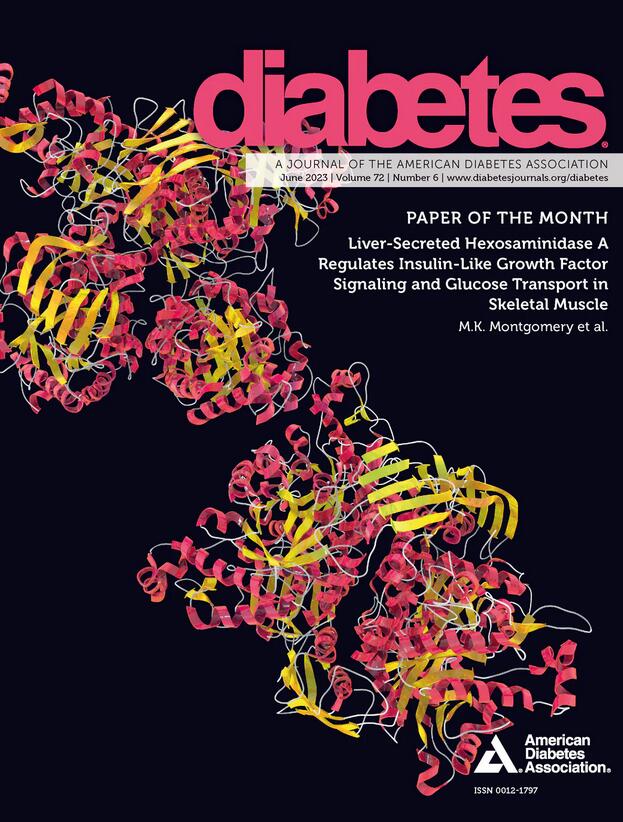人类ipsc -胰岛素抵抗心肌细胞模型的系统生物学和功能评估捕捉糖尿病心肌病的关键特征
IF 7.5
1区 医学
Q1 ENDOCRINOLOGY & METABOLISM
引用次数: 0
摘要
以人为中心的糖尿病性心肌病(DbCM)模型需要为糖尿病患者提供机制见解和翻译相关的治疗靶点。利用胰岛素抵抗(IR)二维(2D)人诱导多能干细胞来源的心肌细胞(hiPSC-CMs)和三维(3D)工程化心脏组织(EHT)的系统生物学方法提供了对失调通路的全面评估,并确定了作为DbCM翻译相关模型的适用性。利用转录组学和蛋白质组学评估,在IR介质中2D或3D EHT中培养hiPSC-CMs可诱导胰岛素抵抗,并激活与DbCM相关的多种途径,包括代谢重塑、线粒体功能障碍、细胞外基质重塑、内质网应激和对缺氧的迟钝反应。在IR 2D和3D平台上的代谢通量测量显示脂肪酸氧化和脂质储存增加,而葡萄糖代谢下调。在3D EHTs中建模DbCM比2D hiPSC-CM具有额外的代谢和功能优势,显示收缩性和肌肉结构受损。二甲双胍治疗改善了收缩力和代谢功能,证明了IR EHT在药物评估中的实用性。总之,红外2D和3D hiPSC-CM模型有效地捕获了DbCM的关键特征。然而,3D EHT提供了对生理和结构变化的额外见解。这突出了红外EHT在DbCM的机制研究和药物筛选方面的潜力。为了了解2型糖尿病的发病机制和开发新的治疗方法,需要以人类为中心的心脏模型来概括2型糖尿病心肌的机制和功能变化。利用人诱导多能干细胞来源的心肌细胞(hiPSC-CM)作为工程化心脏组织(EHT),在细胞中建立糖尿病心肌病模型。采用不偏不倚的系统生物学方法,我们的细胞模型概括了糖尿病心肌病的失调途径和功能紊乱。三维EHT模型显示与患者相似的收缩功能障碍,二甲双胍逆转了机制和功能变化。有可能产生翻译相关的hiPSC-CM模型,模拟糖尿病性心肌病。本文章由计算机程序翻译,如有差异,请以英文原文为准。
Systems Biology and Functional Assessments of Human iPSC-Cardiomyocyte Models of Insulin Resistance Capture Key Hallmarks of Diabetic Cardiomyopathy
Human-centric models of diabetic cardiomyopathy (DbCM) are needed to provide mechanistic insights and translationally relevant therapeutic targets for patients with diabetes. A systems biology approach using insulin resistant (IR) two-dimensional (2D) human induced pluripotent stem cell–derived cardiomyocytes (hiPSC-CMs) and three-dimensional (3D) engineered heart tissue (EHT) provides a comprehensive evaluation of dysregulated pathways and determines suitability as a translationally relevant model of DbCM. Culturing hiPSC-CMs in 2D or 3D EHT in IR media induced insulin resistance and activated multiple pathways implicated in DbCM, including metabolic remodeling, mitochondrial dysfunction, extracellular matrix remodeling, endoplasmic reticulum stress, and blunted response to hypoxia, as assessed using transcriptomics and proteomics. Metabolic flux measurements in both IR 2D and 3D platforms demonstrated increased fatty acid oxidation and lipid storage, whereas glucose metabolism was downregulated. Modeling DbCM in 3D EHTs conferred additional metabolic and functional advantages over the 2D hiPSC-CM, demonstrating impaired contractility and muscle architecture. Metformin treatment improved both contractility and metabolic function, demonstrating the utility of IR EHT for drug assessment. In conclusion, IR 2D and 3D hiPSC-CM models effectively capture key DbCM features. However, 3D EHT provides additional insights into physiological and structural modifications. This highlights the potential of IR EHT for both mechanistic studies and drug screening in DbCM. Article Highlights Human-centric cardiac models are needed that recapitulate mechanistic and functional changes in the type 2 diabetic myocardium for understanding disease pathogenesis and developing new therapies. Using human induced pluripotent stem cell–derived cardiomyocytes (hiPSC-CM) in 2D and 3D as engineered heart tissue (EHT), we aimed to model diabetic cardiomyopathy in cellulo. Taking an unbiased systems biology approach, our cellular models recapitulated the dysregulated pathways and functional derangement of diabetic cardiomyopathy. Three-dimensional EHT models showed contractile dysfunction akin to that seen in patients, with mechanistic and functional changes reversed with metformin. It is possible to generate translationally relevant hiPSC-CM models that mimic diabetic cardiomyopathy.
求助全文
通过发布文献求助,成功后即可免费获取论文全文。
去求助
来源期刊

Diabetes
医学-内分泌学与代谢
CiteScore
12.50
自引率
2.60%
发文量
1968
审稿时长
1 months
期刊介绍:
Diabetes is a scientific journal that publishes original research exploring the physiological and pathophysiological aspects of diabetes mellitus. We encourage submissions of manuscripts pertaining to laboratory, animal, or human research, covering a wide range of topics. Our primary focus is on investigative reports investigating various aspects such as the development and progression of diabetes, along with its associated complications. We also welcome studies delving into normal and pathological pancreatic islet function and intermediary metabolism, as well as exploring the mechanisms of drug and hormone action from a pharmacological perspective. Additionally, we encourage submissions that delve into the biochemical and molecular aspects of both normal and abnormal biological processes.
However, it is important to note that we do not publish studies relating to diabetes education or the application of accepted therapeutic and diagnostic approaches to patients with diabetes mellitus. Our aim is to provide a platform for research that contributes to advancing our understanding of the underlying mechanisms and processes of diabetes.
 求助内容:
求助内容: 应助结果提醒方式:
应助结果提醒方式:


